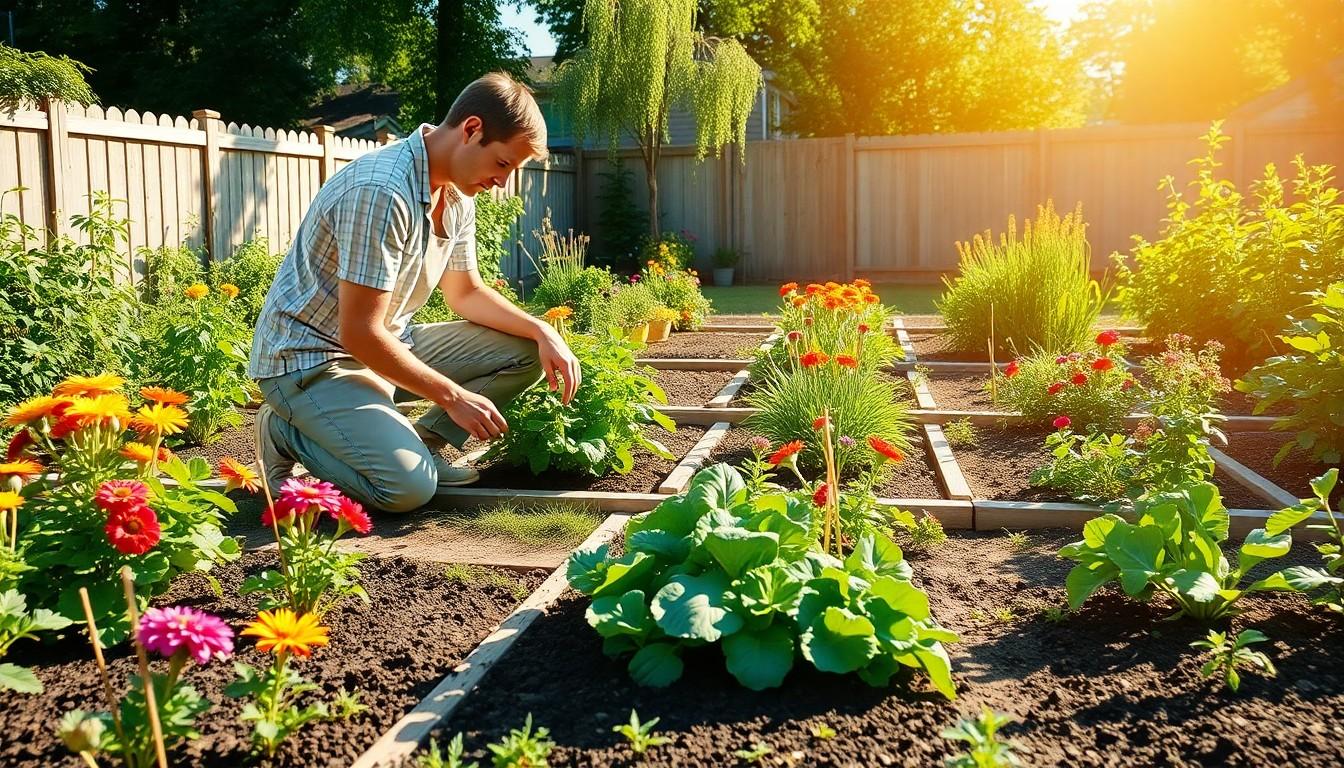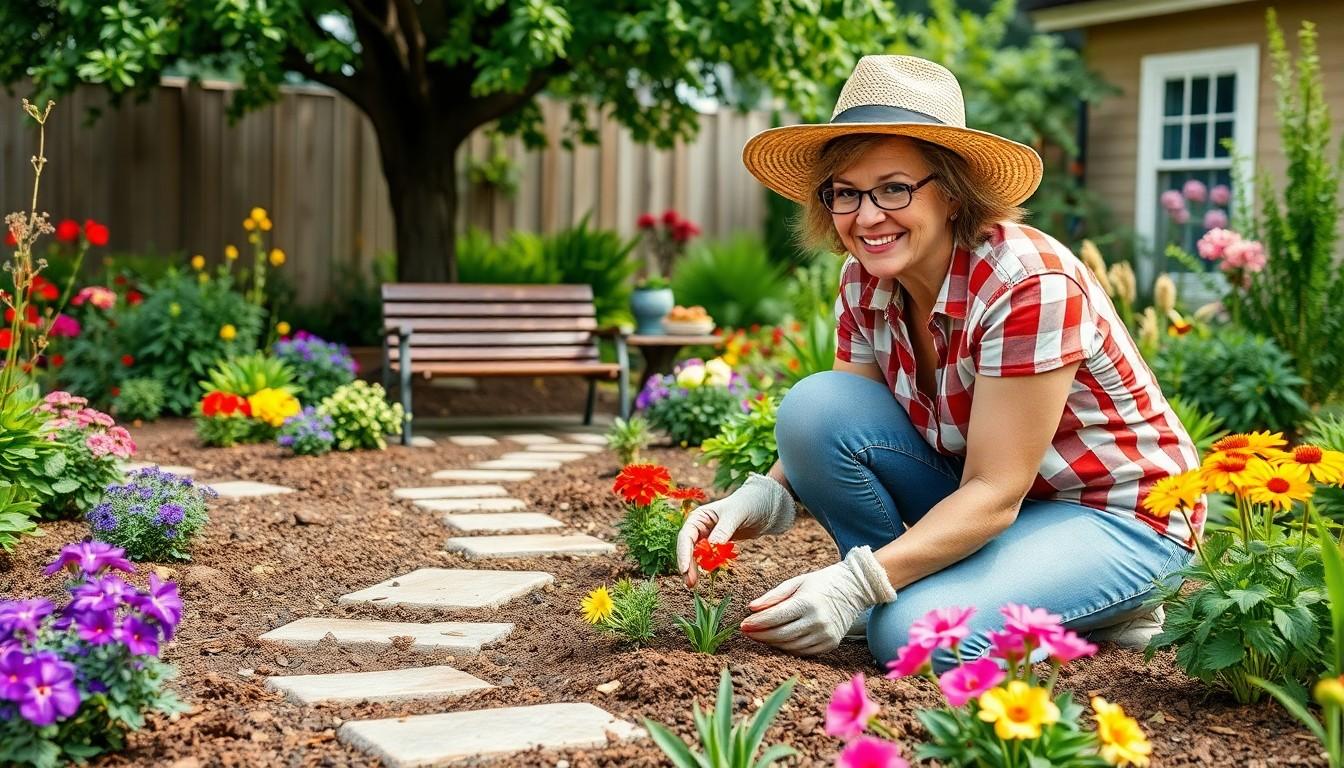Imagine stepping into your backyard and feeling like you’ve just entered a botanical wonderland. Backyard gardening design isn’t just about plants; it’s about transforming a patch of grass into your personal Eden. Whether you dream of a cozy nook filled with vibrant flowers or a veggie patch that could make any chef jealous, the right design can make it happen.
Backyard Gardening Design
Backyard gardening design plays a vital role in creating an aesthetically pleasing and functional space. A well-thought-out design can transform an ordinary yard into a vibrant landscape that caters to personal preferences.
Importance of Backyard Gardening Design
Designing a backyard garden offers numerous benefits. A thoughtful layout promotes efficient plant growth while maximizing available space. Gardeners can enhance their outdoor enjoyment by incorporating elements that reflect their style. Aesthetics matter; visually appealing gardens can significantly increase property value. Additionally, a well-designed garden can improve environmental health by supporting biodiversity and encouraging sustainability.
Key Elements to Consider
Several key elements influence successful backyard gardening design. Plant selection should align with local climate conditions to ensure optimal growth. Soil quality ranks high on the list; healthy soil supports robust root development. Consideration of light exposure is crucial, as different plants require varying amounts of sunlight. Pathways and functional areas enhance accessibility, making maintenance easier. Finally, integration of decorative elements adds character, creating a unique space tailored to individual tastes.
Planning Your Backyard Garden
Thoughtful planning sets the foundation for any successful backyard garden. Specific elements enhance both the aesthetics and functionality of the space.
Assessing Available Space
Begin by measuring the garden area. Determine the total square footage to understand the garden’s potential. Consider existing structures like fences, patios, or trees that might affect planting options. Analyze sunlight patterns throughout the day, recognizing areas that receive full sun, partial shade, or full shade. Assess soil quality by testing pH and nutrient levels, ensuring healthy plant growth. Evaluate drainage capabilities as standing water can hinder plant health. Consolidating these assessments guides the overall design and influences plant selection.
Choosing the Right Location
Selecting the optimal location for a garden is paramount. Aim for a spot that gets at least six hours of sunlight daily for most vegetables and flowers. Proximity to a water source simplifies irrigation and supports plant hydration. Avoid low-lying areas to prevent moisture retention, which can lead to root rot. Pick locations away from strong winds that could damage delicate plants. Accessibility to the garden enhances maintenance, making it easier to weed, harvest, and prune. Prioritize areas that align with lifestyle preferences for a more enjoyable gardening experience.
Designing Your Layout
Creating an effective layout for a backyard garden enhances both functionality and aesthetics. Consider how different elements interact within the space.
Different Design Styles
Eclectic designs combine various plants, colors, and textures, creating dynamic visual interest. A formal style emphasizes symmetry, employing geometric shapes and structured pathways. Rustic gardens utilize natural materials and native plants, promoting a relaxed, organic ambiance. Modern designs favor minimalism, featuring clean lines and a limited color palette. Each style offers unique benefits, allowing gardeners to express their personal preferences while creating an inviting environment.
Incorporating Functional Areas
Functional areas enhance the usability of backyard gardens. Seating spaces provide relaxation spots, encouraging enjoyment of the garden’s beauty. Pathways facilitate easy access between different sections, making maintenance more manageable. Planting zones can define areas for vegetables, herbs, or flowers, ensuring efficient growth conditions. Water features add tranquility while attracting wildlife, enhancing biodiversity. Designing these spaces thoughtfully transforms a garden into a vibrant, multifunctional sanctuary.
Selecting Plants and Features
Selecting the right plants and features for a backyard garden significantly enhances its appeal and functionality. Consider local climate and soil conditions during the selection process.
Choosing the Right Plants
Choose plants that thrive in the specific environment of the garden. Assess hardiness zones, which indicate which plants grow well in local climates. Incorporate a variety of native plants, as they typically require less maintenance and support local wildlife. Add perennials for lasting beauty and annuals for seasonal color. Include herbs and vegetables for practical gardening. Mixing heights and colors creates visual interest, encouraging an engaging atmosphere. Group plants with similar water and sunlight needs, simplifying care and maximizing growth potential.
Adding Garden Features
Adding features transforms a simple garden into a captivating landscape. Start with pathways that facilitate movement and connect various areas. Consider decorative elements like trellises, planters, or garden sculptures for added charm. Install seating areas to invite relaxation and contemplation. Water features, such as fountains or ponds, introduce soothing sounds and attract wildlife. Lighting enhances nighttime appeal, highlighting key features and ensuring safety. Thoughtful incorporation of these elements creates a warm and inviting space for enjoyment and connection with nature.
Maintaining Your Backyard Garden
A well-maintained garden ensures lasting beauty and productivity. Regular care keeps plants healthy and thriving throughout the seasons.
Seasonal Maintenance Tips
Spring requires extensive planting and pruning activities. During this time, gardeners prepare soil and choose appropriate plants based on local climate. Summer brings the need for consistent watering and mulching to retain moisture. In fall, cleaning up dead leaves and planting bulbs for spring blooms is essential. Winter activities include protecting perennial plants and planning for the upcoming season’s layout. Each season’s tasks enhance plants’ growth and prepare the garden for future thriving.
Troubleshooting Common Issues
Identifying pests early helps prevent significant damage to plants. Inspect plants regularly for signs of infestations, such as discolored leaves or webbing. Nutrient deficiencies often manifest as yellowing foliage, indicating the need for quality fertilizers. Addressing drainage problems prevents root rot, which can devastate well-established plants. Uneven watering can lead to wilting or overgrowth, so maintaining a consistent schedule is crucial. Recognizing these issues promptly allows for effective solutions and promotes a vigorous, flourishing garden.
Backyard gardening design offers endless opportunities for creativity and personal expression. By thoughtfully planning the layout and selecting the right plants, anyone can create a space that not only looks beautiful but also serves practical purposes. Incorporating features like pathways and seating areas enhances usability while fostering a connection with nature.
Maintaining this garden is crucial for its longevity and productivity. Seasonal care ensures that the garden remains vibrant throughout the year. By addressing challenges as they arise, gardeners can cultivate a thriving environment that reflects their unique style and preferences. Embracing backyard gardening design leads to a rewarding journey filled with growth and enjoyment.


